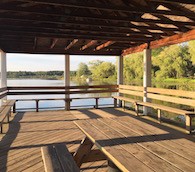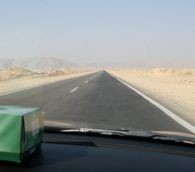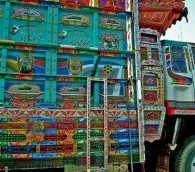Tag: Road Trips
Road Trip to the Spiritual Assembly
by Nancy Davis Kho | 01.26.16 | 12:18 PM ET
When her Aunt Noonie needed company on an annual pilgrimage, Nancy Davis Kho tagged along. Just how "woo-woo" would things get?
New Documentary: ‘Neil Young Journeys’
by Jim Benning | 07.07.12 | 4:22 PM ET
Jonathan Demme’s third documentary about Neil Young, in select theaters now, features a solo performance Young gave at Toronto’s Massey Hall and footage of Young driving across the Ontario countryside, musing about life and his childhood.
‘Get Out of the Damn Car’: An Illustrated Death Valley Road Trip
by Eva Holland | 06.20.12 | 2:49 PM ET
Over at Afar, illustrator Wendy MacNaughton has recreated a brief road trip from San Francisco to Death Valley and back. The drawings include fun headings like “Public Bathroom Ratings” and “Things That Can Be Seen From a Car Window.” I dug it. (Via @The_Rumpus)
Detained in the Sahara
by Bill Donahue | 05.30.12 | 9:47 AM ET
It was night. Soldiers ordered Bill Donahue from the vehicle. Would they administer primitive justice?
Bad ‘Carma’
by David Farley | 08.11.11 | 12:43 AM ET
David Farley wanted to drive only occasionally during his stay in Italy. So why did something always go wrong?
What Does ‘Travel Games’ Mean to You?
by Eva Holland | 07.22.11 | 9:15 AM ET
I had a strange experience yesterday morning. I saw a headline in my feed reader—The Ten Best Travel Games, from The Independent—and I clicked, expecting a nostalgic list of childhood car trip time-killers. You know, low-tech classics like “I Spy.” Instead, I got a slideshow of modern, high-tech options: iPhone apps and, of all things, an electronic Rubik’s Cube.
I can’t be the only one who still thinks “I Spy” when I hear “travel games,” can I? Or has everyone else embraced in-car gaming and iPads for every passenger? What do you think of when you hear the words “travel games”?
The Partridge Family Meets Ken Kesey on the Grand Trunk Road
by Michael Yessis | 06.27.11 | 11:41 AM ET
James Parchman spent days on a Pakistani stretch of the fabled Grand Trunk Road, wowed by the ornate decorations he saw on so many passing vehicles. The “panorama of red, yellow and green, mixed with plastic whirligigs, polished mahogany doors and gleaming stainless steel cover plates,” he writes, is part pride of design, part advertising expense.
Durriya Kazi, an artist and teacher in Karachi, has long been a proponent of Pakistan’s folk art. She sees bus and truck decorating as an integral part of that tradition, noting the importance of distinguishing between sculpture as defined by the art gallery and the rich activity of actually making things that exists all over Pakistan.
In 2006, Ms. Kazi was instrumental in a program intended to spread Pakistan’s bus decoration skills to Melbourne, Australia, where a tram was transformed into a replica of a minibus used on Karachi’s W-11 route, resplendent in all its finery.
Another Pakistani with expertise in the subject is Prof. Jamal J. Elias of the University of Pennsylvania, the author of “On Wings of Diesel: Trucks, Identity and Culture in Pakistan” (Oneworld, 2011). His book explores the tradition of Pakistani truck decoration, and looks into the “nature of response to religious imagery in popular Islamic culture.”
A terrific slideshow accompanies Parchman’s piece.
For another look at the Grand Trunk Road, check out Jeffrey Tayler’s five-part series, Cycling India’s Wildest Highway.
R.I.P. Alberto Granado, Travel Companion to Che
by Jim Benning | 03.07.11 | 11:39 AM ET
The fellow Argentinian who joined Che Guevara on the Latin American road trip immortalized in The Motorcycle Diaries has died in Cuba at the age of 88.
On their journey:
As young medical students, they witnessed deep poverty across the continent, particularly Chile, Colombia, Peru and Venezuela, and their stay at a Peruvian leper colony left a lasting impression on the pair.
They parted ways in Venezuela, where Granado stayed on to work at a clinic treating leprosy patients.
In 1961, Granado moved to Cuba, where he taught biochemistry at Havana University.
Related: Will ‘The Motorcycle Diaries’ Spawn a New Magazine: Condé Nast Revolution?
‘You’re from Idaho? Oh, Iowa? Whatever. Same thing, right?’
by Eva Holland | 01.24.11 | 3:18 PM ET
Over at The Atlantic, Midwesterner Ann Friedman contemplates an adult life spent mostly on the coasts:
In New York, San Francisco, and D.C. I got used to hearing, “You’re from Idaho? Oh, Iowa? Whatever. Same thing, right?” This is perhaps why I love to visit cities and parts of the country not typically defined as tourist destinations. Pittsburgh. Peoria. Milwaukee. Wichita. Reno. When I told friends who had only lived on the coasts that I was about to embark on a month-long road trip, most were jealous. They’ve always wanted to do a cross-country drive! To face their fears of the limited menu at Country Kitchen, the bleakness of the Nebraska landscape, sexist good ol’ boys and racist yokels. Maybe to assuage a low-level guilt that they have been to rural India but never rural Indiana.
Ouch.
The Critics: ‘Due Date’
by Eva Holland | 11.08.10 | 2:38 PM ET
When I first wrote about “Due Date” a few months back, I compared it to the 1980s road trip classic, “Planes, Trains and Automobiles.” Now that the movie has arrived in theaters, many critics are drawing the same parallel—but the new flick, starring Robert Downey Jr. and Zach Galifianakis, just doesn’t hold up when compared with “Planes, Trains.”
New York Magazine’s David Edelstein describes “a premise so wrung-out I’m bored recounting it—two viscerally mismatched people thrown together on a desperate road trip,” and the Christian Science Monitor’s Peter Rainer suggests that “if the comic premise of this film appeals to you, you’d be better off renting ‘Planes, Trains and Automobiles’.” Over at Slate, Dana Stevens adds: “It’s not that a reworking of this familiar material couldn’t be made funny again, but it would take a lot more imagination than this movie, directed by dude-comedy auteur Todd Phillips (‘Road Trip,’ ‘Old School,’ ‘The Hangover’), seems willing to put in.”
I caught the movie this weekend, too, and I was not impressed. The drive from Atlanta to L.A.—a road trip with plenty of potential—provided only a few miserly scenic shots, and while there was a handful of good laughs, too many of the jokes fell flat. I’ll give David Edelstein the last word:
At journey’s end, though, “Due Date” is less than exhilarating. It’s still a formula mismatched buddy movie that goes nowhere you haven’t been, happy to hug the Interstate, willfully oblivious to other roads and a more surprising—and even more riotous—world elsewhere.
Why Walter Kirn Clings To Kerouac
by Michael Yessis | 11.01.10 | 4:17 PM ET
The man who introduced us to Airworld likes to bypass Airworld. For the last four years, Kirn has made regular driving trips from Livingston, Montana to Los Angeles, to stay in touch with “the gritty ‘real America’ of perpetually flooded truck-stop men’s rooms and quickie meals of stale tortilla chips doused in liquid cheese dispensed from pumps.”
I pay a high price for clinging to Kerouac in the age of frequent-flyer programs. I’ve worn out a couple of engines on my commute, a few sets of tires, and one or two relationships. I’ve also worn myself out, partly because whenever I make the trip, I tell myself I can do it without sleeping. It’s difficult, though. The problem is Mormon coffee. In Utah, the state in the middle of my trek (a place of allegedly spectacular scenery that I always seem to cross at night, anaesthetized by the synthetic murmur of ‘80s soft rock from my satellite radio) caffeine is deemed a narcotic, not a vitamin. It’s obtainable, sure, but only with an effort, and it’s weak when you find it. You sort of have to know a guy.
Happy Birthday, Alaska Highway
by Eva Holland | 10.29.10 | 4:34 PM ET
The road, built in the midst of World War II thanks to fears of a Japanese invasion, turns 68 today. It’s come a long way since its opening to military traffic—when, according to Wired writer Tony Long, it was “a glorified footpath with stretches of unpaved road, murderous switchbacks and no guard rails or shoulders”—but I still think it makes for one of the great North American drives. Here’s to many more road trips yet to come.
Could Google’s Self-Driving Cars Ruin the Road Trip?
by Eva Holland | 10.25.10 | 1:48 PM ET
I’d never thought about the implications of a pre-programmed vehicle doing my navigating for me, but Budget Travel blogger Nicholas DeRenzo is thinking way ahead. He outlined his concerns in a recent blog post:
Stumbling upon off-the-beaten path destinations—from random roadside attractions to gas station barbecue joints to small town drive-in theaters—is what makes road trips so popular. Unless you remember to punch the world’s largest jackalope or the Cadillac Ranch into your GPS system, you’re all but guaranteed to miss these icons of Americana if you’re in a self-driving car. In a sense, you’ll lose the ability to get lost.
A more optimistic commenter responds:
The high-speed freeways running across the country made Route 66 obsolete, but there are still those of us that make it a point to go off the beaten path and embrace the spirit of discovery. Even if the Google self-driven car becomes standard, there will be a way to “go manual”, I’m sure.
Pacific Coast Highway: ‘Easily the Best in America’
by Eva Holland | 10.18.10 | 12:39 PM ET
Over at The American Scene, Conor Friedersdorf waxes nostalgic about PCH:
Few things satisfy me as much as driving on certain stretches of Pacific Coast Highway, a road that is easily the best in America, and that I can’t imagine being equaled elsewhere. There is a mile or two in south Laguna Beach that I associate with summer days at age sixteen, driving with Feel Flow or Scarlet Begonias blaring on the stereo, sand on my feet, surf wax beneath my fingernails, and windows down to achieve that singular sensation of evaporated saltwater on skin dried by a warm 55 MPH breeze. Call it beach feel, which usually also involves a slight sunburn, muscles tired from fighting currents all day, and the kind of hunger that makes an In’N'Out burger even better than usual.
‘Is Civil War Tourism Fun?’
by Eva Holland | 10.05.10 | 1:41 PM ET
This coming spring marks the 150th anniversary of the onset of the Civil War. John Swansburg, anticipating an upsurge in Civil War tourism as a result, is getting out ahead of the pack—and he’s documenting his jam-packed ten-day Civil War road trip in a series of dispatches for Slate. He begins the trip with a series of questions:
Over the next four years, scores of fathers will use the sesquicentennial celebration as an excuse to don their safari shirts and trundle forbearing wives and irritable children off to Gettysburg or Spotsylvania or Chickamauga. What will they see? Will they learn something they couldn’t have picked up from watching Ken Burns or reading Battle Cry of Freedom? Can visiting these places turn a layman into a buff? Is Civil War tourism fun?
The Wired Guide to Road Tripping in Kabul
by Eva Holland | 09.21.10 | 1:54 PM ET
Zach Rosenberg shares some lessons learned from four months of driving in the Afghan capital. The story includes some fascinating observations alongside the practical advice—Kabul’s most popular bumper stickers may surprise you.
High-mileage Toyota Corollas are so ubiquitous as to deserve a place on the Afghan flag. In fact, if you’re in Kabul, you’re probably driving one. Most of them are well-worn imports from Canada, the United States, Germany and other western nations and many bear stickers or flags identifying them as such. They often sport bumperstickers from their homelands. Logos of American universities are common. Less common but endlessly ironic are the occasional “Bush/Cheney ¹04,” “Jesus Saves” and “My Child is a Star Pupil At…” stickers.
Retracing Steinbeck’s ‘Travels With Charley’
by Jim Benning | 09.20.10 | 3:50 PM ET
Fifty years ago this week—on Sept. 23, 1960—John Steinbeck set out on the 10,000-mile road trip that would inspire the classic American memoir, “Travels With Charley.”
This Thursday, writer Bill Steigerwald will set out to retrace Steinbeck’s journey. He plans to write about it, using the trip as “the frame for a book that compares simple, poor, square 1960 America with 2010 America.”
He admits the two journeys will be very different.
Steinbeck camped out under the stars a bunch of times. I won’t. He drove a clunky uncomfortable truck with a Spartan camper shell on its back. I’ll stay at pre-1960 motels when I can and drive a 2010 Rav4 I can sleep in when I must. When Steinbeck was on the road he had only an AM radio and pay phones to keep him tethered to the world. I’ll have enough communication gear for a trip to the moon.
The book “Travels With Charley” will be my map/guide/timeline to the places Steinbeck went and the things he mused, complained or fretted about. Unfortunately, “Charley” is not a travelogue and wasn’t meant to be. It’s often vague and confusing about where Steinbeck actually was on any given date, and Steinbeck, who died in 1968, left no notes, no journal, no expense records.
There’s more information and an interactive map here.
World Travel Watch: Tube Strikes Looming in London, China’s Epic Traffic Jam and More
by Larry Habegger | 08.25.10 | 11:59 AM ET
Larry Habegger rounds up global travel news
Life on I-95: ‘The Road Most Traveled’
by Michael Yessis | 08.25.10 | 10:00 AM ET
NPR’s Weekend Edition launched an ambitious series Saturday, a three-weekend-long look at the most trafficked interstate in the U.S. It’s not this trafficked, but it’s pretty busy. And it plays a huge role in American life:
All along the Eastern Seaboard, Interstate 95 has helped shape the daily lives and vacation dreams of the roughly 100 million people who reside alongside it. They live in dense cities and rural counties in the 15 states through which I-95 passes on its nearly 2,000-mile, north-south path.
The Department of Transportation says that each year I-95 gets more VMTs—that’s vehicle miles traveled—than any other road. The traffic on I-95 peaks in August as legions of vacationers and college students join commuters, truckers, migrant farm workers and others on the road.
As an accompaniment, NPR recommends 95 songs for driving on I-95.
China’s 10-Day Traffic Jam, in Photos
by Eva Holland | 08.24.10 | 4:50 PM ET
NPR has a sequence of remarkable photos from the ongoing jam, which stretches for more than 60 miles. Hat tip to Boing Boing’s Maggie Koerth-Baker, who speculates about how the AP photographers managed to make it to and from the scene: “I’m imagining a dirt bike was involved.”
- « Prev Page
- Next Page »





